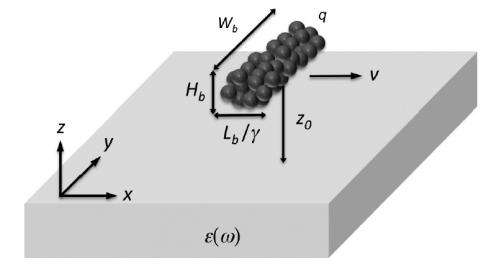January 8, 2013 feature
Metal surface can repel electric charges

(Phys.org)—Metals are known for being good electrical conductors. Due to this property, a stationary electric point charge placed outside a metal will cause the electrons in the metal to redistribute in such a way that the point charge will always be attracted toward the metal surface. However, a new study shows that a metal surface will repel an electric charge packet moving parallel to it when the charge packet has a certain geometry and travels at a sufficiently high energy. It's not just metal surfaces that repel electric charges; any surface will repel this kind of charge packet since the repulsion is caused by the properties of the packet, not the surface. The counterintuitive phenomenon could have implications for improving particle accelerator experiments.
Primož Rebernik Ribič, a physicist at Ecole Polytechnique Fédérale de Lausanne (EPFL) in Lausanne, Switzerland, has published his study on metal and other surfaces repelling electric charges in a recent issue of Physical Review Letters.
As Ribič explains, the interaction between solid surfaces and point charges has been extensively studied, with a classic article by Bolotovskii on the subject published in 1962. More recently, scientists have thoroughly studied the interaction between solid surfaces and charge packets that are elongated in the longitudinal direction (parallel to their motion). However, much less is known about transverse packets, which are elongated in the direction perpendicular to their motion. Ribič has found that the behavior of these packets unexpectedly departs from that of the other two charge geometries.
Ribič explains that the phenomenon is easier to understand if one considers the special case of a charge packet moving parallel to the surface of a dielectric. In this case, the packet experiences a force due to two kinds of electromagnetic waves excited in the solid: evanescent waves and Čerenkov waves. Evanescent waves, which exist very close to the surface of the solid, always contribute an attractive force to the charges at all energies. However, the contribution from Čerenkov waves, which travel into the solid, is zero or attractive at low energies, but becomes repulsive at high energies. The reason for this change at high energies is that radiating Čerenkov waves carry a certain momentum into the solid. This momentum has to be balanced by the charge packet, which results in a repulsive force.
So at low energies, the attractive components dominate the transverse force, regardless of the charge packet geometry. But even though the Čerenkov contribution becomes repulsive at high energies, previous research has shown that, for point charges, the total force remains attractive at all energies.
When investigating transverse charges, however, Ribič discovered a different result. He found that the geometry of the transverse charges suppresses the evanescent waves, which decreases their attractive contribution and allows the Čerenkov wave repulsion to dominate at high energies to produce an overall repulsive force.
This effect is due to the fact that a "long" charge packet, i.e., one with a high ratio of transverse to longitudinal size, will suppress evanescent waves propagating at large angles with respect to the packet velocity. When this ratio is increased infinitely, resulting in a line charge with infinite transverse length, the range of angles is reduced to zero. In other words, all waves except those propagating in the forward direction, i.e., Čerenkov waves, are suppressed.
Ribič showed that repulsion can occur between a transverse charge packet and either a dielectric or a metal surface, implying that the repulsive interaction is caused by the geometry of the packet. However, the case with the metal surface is the most interesting. Ribič explained that the finding that a metal surface can repel certain kinds of electric charges will change the way scientists solve problems involving electric charges.
"In electrostatics, one is used to solving problems with simple charge geometries using the so-called method of images," Ribič told Phys.org. "For a single point charge above a metal surface, the force between the charge and the metal is equal to the force between the original charge and an opposite charge placed at twice the distance of the original charge from the surface. This also works for line charges and sheets. This method will always give you an attractive force. The method doesn't work anymore for charges moving at relativistic speeds, which the paper demonstrates. Besides the standard attractive interaction, which is due to evanescent waves, there is also repulsive interaction due to propagating Čerenkov waves. One has to take this into account whenever dealing with charge distributions other than point charges."
The results not only add to scientists' understanding of fundamental electrodynamics, but could also prove useful for designing particle accelerator experiments. When a high-energy charge gets close to the surface of an accelerator wall, it produces transverse and longitudinal wakefields that can negatively affect the beam properties. Ribič predicts that manipulating the packet geometry may help alleviate this effect.
In the future, Ribič hopes that further investigations into the largely neglected effects of charge geometry will have even greater fundamental and practical consequences.
"We will probably also check what happens with other geometries," he said. "One interesting example would be a ring of charge with a large radius. For an infinitely large ring, one should also get repulsion between a ring that is placed into a guiding tube of an accelerator. Then the question is how the ring and tube radius affect the interaction. We are also planning to explore the interaction between charges and anisotropic media (such as uniaxial dielectrics)."
More information: Primož Rebernik Ribič. "Can a Metal Surface Repel Electric Charges?" Physical Review Letters 109, 244801 (2012). DOI: 10.1103/PhysRevLett.109244801
Journal information: Physical Review Letters
Copyright 2013 Phys.org
All rights reserved. This material may not be published, broadcast, rewritten or redistributed in whole or part without the express written permission of Phys.org.

















